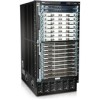Dell PowerConnect J-8216 Hardware Guide - Page 43
RE Module LEDs in a J-EX8216 Switch
 |
View all Dell PowerConnect J-8216 manuals
Add to My Manuals
Save this manual to your list of manuals |
Page 43 highlights
Chapter 2: Component Descriptions • Powers the line cards on and off • Powers the Switch Fabric (SF) modules on and off • Performs routing functions for the switch • Controls system resets and the boot sequence for the switch • Monitors and controls the speed of the fans in the fan trays • Monitors and controls the LCD panel and chassis status LEDs • Monitors the communication of the line cards with the switch fabric on the Switch Fabric (SF) modules • Monitors the status of the power supplies The RE module has these components: • RE module LEDs-Indicate system status. See "RE Module LEDs in a J-EX8216 Switch" on page 27. • Recessed reset button-Power cycles the RE module when pressed. • USB port-Provides an interface through which you can install the Junos OS manually. See "USB Port Specifications for a J-EX Series Switch" on page 49. • Auxiliary port-This port is not enabled on J-EX8200 switches. It is reserved for future use. • Console port-Connects the RE module to a system console through a cable with an RJ-45 connector. See "Connecting a J-EX Series Switch to a Management Console" on page 136. • Management port-Connects the RE module through an Ethernet connection to a management LAN (or any other device that plugs into an Ethernet connection) for out-of-band management. See "Connecting a J-EX Series Switch to a Network for Out-of-Band Management" on page 135. • Ejector levers-Used for installing and removing the RE module. • Captive screws-Secure the RE module in place. Related • Installing an RE Module in a J-EX8216 Switch on page 118 Documentation • Removing an RE Module from a J-EX8216 Switch on page 163 RE Module LEDs in a J-EX8216 Switch Each Routing Engine (RE) module has four LEDs on the left side of the module's front panel. See Figure 11 on page 28. 27















